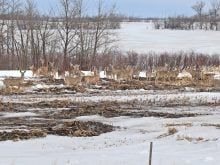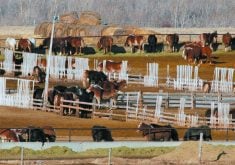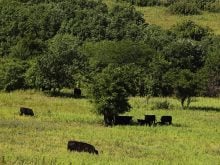Influenza and its causes in people can be an ever-evolving process.
At one time we rarely heard about influenza in cattle because there appears to be different factors in cattle serum and their immune response that causes a hindrance to the influenza virus.
That is a great thing.
It changed in about 2010 when reports appeared of an influenza D strain in cattle worldwide. The incidence of it seems to be increasing so we need to be on the lookout for it.
Time will tell how this disease will emerge in the cattle population.
Read Also

Trump’s tariffs take their toll on U.S. producers
U.S. farmers say Trump’s tariffs have been devastating for growers in that country.
Cattle hosts of this form of influenza and they can give it to each other and occasionally to swine or sheep and goats.
I have diagnosed one case in the last year. Incidence has gone up enough that now, for instance, the Prairie Diagnostic Services laboratory at Saskatoon is screening for it when diagnosing respiratory pathogens.
If a respiratory case is submitted, they look for the bacteria and respiratory viruses.
Corona virus is often more of a mild respiratory disease but a pharmacy company came up with an intranasal vaccine for corona virus respiratory disease and found out that it worked better for the prevention of corona virus diarrhea.
One should always pay attention to new vaccines. They are really the key, along with management, to preventive medicine.
Antimicrobial use is decreased and performance is enhanced with appropriate vaccine use.
In one influenza D case, an experienced owner-initiated treatment for respiratory disease and the animal was not responding. This occurred despite early detection and the animal’s temperature being taken down with antimicrobials and NSAIDs.
When the animal’s temperature increased again, I knew we were in trouble. Respiratory sounds were evident in the lungs, temperature was above normal and the animal was unresponsive to treatment.
Despite aggressive treatment, this heifer died and there was an acute onset of a complete interstitial pneumonia, which is typical of a viral pneumonia.
This heifer was up to date on all respiratory preventive vaccinations.
With viral pneumonias, we try to give nonspecific treatments to bide us some time. Veterinarians prescribe things like NSAIDs or steroids or antihistamines.
Simple treatments like getting fresh air and air movement are always considered by veterinarians. Some immune stimulants such as zelnate may have some beneficial results. These are all worth trying on viral pneumonias in my opinion but viral pneumonias are uncommon and often unresponsive to treatment.
Somewhat similar is the recent COVID-19 outbreak where ancillary treatment, as well as a respirator is what was required. With viral pneumonias the main preventive measure is vaccination.
Influenza vaccines are relatively easy to make and we see vaccines for human influenza designed to fight several common strains with one dose.
The same is true in the equine world. Flu in horses can be pathogenic and long lasting, so horses are commonly vaccinated for it.
If incidence of the influenza D in cattle keeps increasing, a vaccine manufacturer may add this component in one of their respiratory vaccines.
Incidence is not high to date but when it does occur, mortality is high and those that survive often have permanent respiratory damage.
The incident rate of influenza D may be higher than we think because it appears like a severe viral pneumonia on autopsies and many cases are not submitted to laboratories for testing to determine which virus is the actual cause.
Keep on the lookout or have your veterinarian report if they have seen any unusual cases of respiratory disease.
There needs to be more research on this pathogen and its overall effect on the cattle sector.
Producers must be aware of it as an issue to watch for.
All the risk factors that lead to increases in respiratory disease could lead to more influenza D.
Roy Lewis works as a veterinarian in Alberta.















